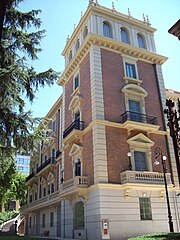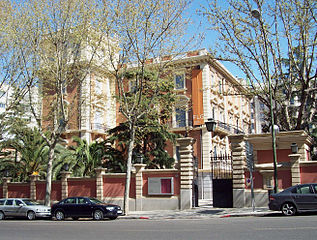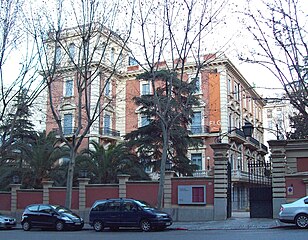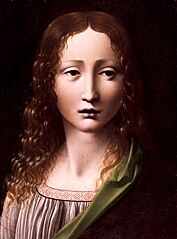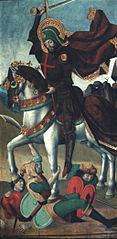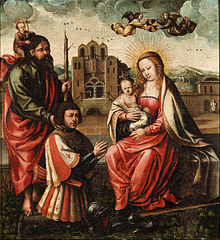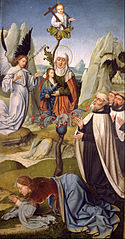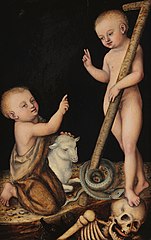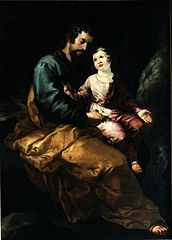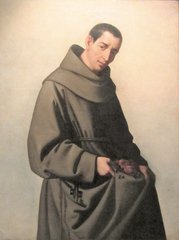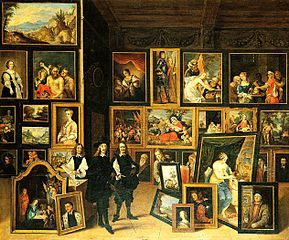Museo Lázaro Galdiano
Jump to navigation
Jump to search
Español: El Museo Lázaro Galdiano, situado en Madrid (España), es un museo estatal de origen privado, que alberga una amplia y heterogénea colección, formada con interés enciclopédico hacia todas las artes y técnicas. Este excepcional conjunto, constituido por unas 12.600 piezas, fue reunido por el editor José Lázaro Galdiano, quien al morir en 1947 lo legó al Estado español junto con su residencia madrileña, la sede de su editorial La España Moderna y una biblioteca de 20.000 volúmenes. Entre sus obras de arte más valiosas destaca el conjunto de pinturas, dibujos y grabados de Goya, con piezas mundialmente conocidas. También hay que citar ejemplos relevantes de El Bosco, Lucas Cranach el Viejo, El Greco, Murillo, Zurbarán y Luis Paret, así como una miniatura en pergamino de Giulio Clovio y dos estatuillas de Giambologna. Pero posiblemente la obra más singular del museo es la pintura sobre tabla El Salvador joven, del círculo de Leonardo da Vinci. Posee además un pequeño conjunto de pintura británica, una escuela muy poco frecuente en España; de hecho el Lázaro Galdiano y el Museo del Prado eran (hasta la apertura del Museo Thyssen-Bornemisza) los dos únicos museos españoles con una colección significativa. Incluye ejemplos de Lely (el único del siglo XVII, los demás son del XVIII), Constable, Reynolds y Romney, a los que se suma un retrato del estadounidense Gilbert Stuart.
English: The Museum of Lázaro Galdiano (Spanish: Museo Lázaro Galdiano) is a museum located in Madrid, (Spain). It houses the art collection of José Lázaro Galdiano. The palatial building was constructed in 1903 as the residence of Lázaro Galdiano and his wife and is set within grounds that also hold the library containing Galdiano's important collection of incunabula and manuscripts. The conversion to a museum has respected the original interiors, which feature elaborate baroque painted ceilings commissioned by Galdiano; and the building was declared Bien de Interés Cultural in 1962. The Museum contains important collections of valuable works of from the prehistoric period to the nineteenth century, with a focus on Iberian work. Major categories include jewellery, small bronzes, both ecclesiastical and domestic silver, ceramics, carved ivory, and numismatics. Objects come not only from Iberia, but from major centers of medieval artistry including Limoges and Egypt. While the Renaissance is especially well represented, the collection features important early medieval objects including Visigothic work, and works crafted by Iberia's ancient Celtic culture.
| Location: 40°26′13″N 3°41′09″W / 40.436917°N 3.685806°W |
Building / Edificio[edit]
Exterior / Exterior[edit]
-
Exterior.
-
Exterior.
-
Exterior.
-
Exterior.
-
Exterior.
-
Exterior.
-
Exterior.
Interior / Interior[edit]
-
Interior.
-
Pasarela de los músicos.
Collection[edit]
Paintings[edit]
15th-century paintings / Pinturas del siglo XV[edit]
-
El Salvador adolescente, atribuida a Giovanni Antonio Boltraffio.
-
Tríptico del Nacimiento, del Maestro de Ávila.
-
Coronación de María, de autor desconocido.
-
La Visitación, de Diego de la Cruz o del círculo del Maestro Milá.
-
Santiago Matamoros, de Martín de Soria.
16th-century paintings / Pinturas del siglo XVI[edit]
-
La Virgen de Cristóbal Colón, de autor desconocido.
-
La Virgen de los Carmelitas, de autor desconocido.
-
San Sebastián, de Juan de la Abadía.
-
La Virgen María con el Niño Jesús, de Ambrosius Benson.
-
El Niño Jesús adorado por San Juan Bautista, de Lucas Cranach el Viejo.
17th-century paintings / Pinturas del siglo XVII[edit]
-
San José y el Niño Jesús, de Francisco de Herrera el Viejo.
-
San Diego de Alcalá, de Francisco de Zurbarán.
-
La comunión de Santa Teresa, de Juan Martín Cabezalero.
-
San Jerónimo, de Hendrick van Somer
-
La visita del archiduque Leopoldo Guillermo a su gabinete, acompañado de David Teniers el joven, de David Teniers.
-
La Visitación, de Antonio de Pereda y Salgado.
-
Soldados a la puerta de un mesón, de Jacobus Koolen.


